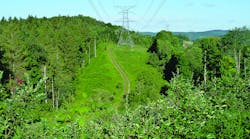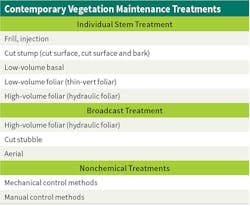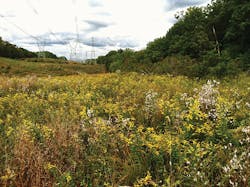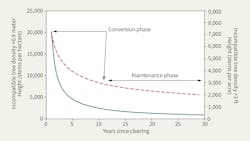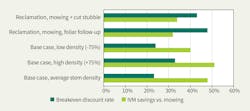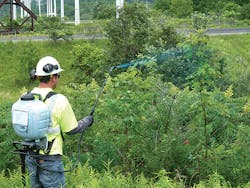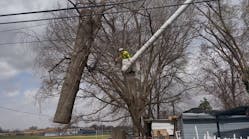Electric transmission line corridors are maintained to ensure safe, adequate clearances between vegetation and energized conductors as well as to provide access to energy delivery infrastructure for inspection, maintenance, repair and restoration of power, should a problem occur. Tall-growing trees are incompatible with the purpose of the right-of-way (ROW) and, if left to grow unchecked, may encroach to within minimum vegetation clearance distances (MVCD) of energized conductors.
The industry uses a variety of methods and strategies to control vegetation, most commonly mechanical-only methods ranging from mechanized mowing to the selective use of herbicides. Economic evaluation of these methods and strategies is rarely published. The Centre for Energy Advancement through Technological Innovation (CEATI) recently completed project 4101, which assesses two vegetation management strategies with different uses of herbicides for maintaining ROW vegetation:
• Using the principles of an integrated vegetation management (IVM) strategy that relies on a variety of treatments and focuses on the selective use of herbicides to control incompatible trees
• Using a non-IVM strategy that relies on repeated mechanized, nonselective cutting of all vegetation without the use of herbicides and other treatments.
Both the literature and experience demonstrate either strategy can reduce the risk of tree-conductor conflict. However, the parameter of interest for this project was defined in terms of the avoided cost of the chosen approach to vegetation management. Thus, the least-cost model is an appropriate choice to analyze herbicide-based versus mechanical treatments. A least-cost analysis establishes the most conservative use of dollars to maintain the ROW. Of note, least-cost analysis focuses exclusively on direct costs and does not consider potential benefits.
Information and Data Considered
Changes in the abundance and size of incompatible trees within a ROW corridor have a direct effect on the cost of vegetation maintenance work that must be completed to achieve management objectives. For this project, a literature review was conducted and used to develop predictive models of changes in abundance and height growth of incompatible tree species over time as well as to develop methods to perform the comparative economic analysis of the two vegetation maintenance strategies.
The literature suggests a wide variety of compatible plant life forms (for example, grasses, ferns, herbs and shrubs) can suppress incompatible trees through interference, or competition, and by providing habitat for seed and seedling predators. The ability of various compatible cover types to resist invasion by incompatible trees differs in the duration of competitive interference effects. Woody shrubs generally are considered better competitors to trees, because they exert interference to tree growth for a longer period compared to other compatible plant life forms.
Few references were identified that compared the cost of vegetation maintenance treatments, and those that did typically reported changes in abundance but not height of target species. The lack of references related to economic factors affecting ROW vegetation maintenance strategies and programs as well as supporting decisions related to vegetation maintenance budgets demonstrated the need for this project.
Delphi analysis methods were adapted and used to engage a wide spectrum of industry experience by subject-matter experts and practitioners in defining contemporary vegetation maintenance practices as well as to acquire cost data. A survey of practices at 18 utilities, which manage a total of 242,000 acres of transmission ROW, was used to confirm initial assumptions of the expert group.
Together, these sources of data were used to develop information regarding the frequency of use for each treatment method. The industry’s experience informed the development of a stocking model that considers both the density and height of incompatible species in characterizing vegetation maintenance methods and costs.
The concept of stocking guided the development of predictive models of changes in stem density and height growth response over time. This required development of production function curves predicting changes in the density of incompatible stems over multiple treatments for both herbicide-based and mechanical vegetation maintenance treatments over time and involving several treatments.
Data from published studies of forest systems and recently cleared ROW supported projections following the initial clearing (the conversion phase) and ROW-specific studies supported modeling changes as the corridor became well established (the maintenance phase).
The ability of herbicide-based treatments to control incompatible trees from the ROW also has a significant effect on predictions of height regrowth response following treatments. Most of the incompatible trees that occur in areas maintained with herbicide treatments are assumed to originate as seedlings. This contrasts with incompatible trees controlled by manual and mechanical cutting, which demonstrates vegetative sprouting and exhibits an exaggerated growth response for at least a few years. As such, a regrowth response production function that predicts height growth following both herbicide and non-herbicide treatments was developed.
Comparative Analysis
The analysis considered the cost of maintaining a ROW corridor after initial clearing through establishment of relatively stable steady-state conditions. Analyses were developed to be applicable broadly to ecosystems across the continental U.S. Vegetative conditions on a ROW can be described in two stages: the conversions from forest cover through establishment of ROW vegetative cover and steady-state maintenance when the ROW is occupied by relatively stable vegetative cover.
Three hypothetical case studies were defined and used in the comparative analysis, and 20-year vegetation maintenance prescriptions specific to each of the case studies were developed. A fourth worst-case study was added to test the durability of findings under extreme and unlikely conditions. The IVM-based programs used a variety of maintenance treatments, and the non-herbicide vegetation maintenance programs relied on repeated mechanical mowing. The present value cost (PV-C20yr) over the projected 20-year prescription horizons were calculated using a 5% discount factor.
Analysis of the base case was bounded by a high and low projection (±75%) in incompatible stem densities that may be encountered in the field (this range captured the general prediction limits of the projection equation). Two additional variants of the base case study were evaluated, each of which created bias that favors the non-herbicide mowing strategy over an IVM-based strategy, using the high and low (±75%) stem density limits.
The 20-year horizon used in the reclamation case study began late in the conversion phase and assumed deferred maintenance led to high stem densities. The loss of herbicide case study focused on the maintenance phase when relatively stable vegetative cover had been established on a ROW.
Least-Cost Findings
The IVM strategy yielded savings in every case study compared to repeated mowing. The breakeven discount rate is the discount factor that would be required for the present value of the treatment costs for the non-IVM strategy to equal the present value of the IVM strategy that uses herbicides. IVM savings are stated in terms of reduction in the equivalent PV-C20yr of repeated mechanical cutting of ROW vegetation.
The base case study vegetation maintenance strategy using the principles of IVM and the use of herbicides was shown to be significantly less costly than a strategy that made no use of herbicides but relied simply on repeated mechanical cutting of vegetation within the ROW.
Three variants were evaluated. The first was based on predictions for average stem densities for incompatible tree species in the base case study. This baseline analysis was bounded by high and low projections made by increasing and decreasing average incompatible stem densities by 75%. This was done to approximate the observed range in density that would be encountered during normal operations. The present value of costs over the 20-year evaluation period was shown to be approximately half as much as simply controlling incompatible trees by cutting without the use of herbicides over the same period.
Three different IVM-based approaches were used in evaluating the reclamation case study on ROW where vegetation maintenance had been deferred. Two began with mowing and a herbicide treatment immediately (cut stubble) or after a full growing season, and subsequent increasingly selective applications over the remaining 20-year study period. A savings of approximately one-third less than the comparable cost of mowing was found for both scenarios.
A third reclamation scenario involved an aerial application of herbicide to tall vegetation without mowing. The aerial application yielded the greatest cost savings (75%), but may have limited application because of the aesthetic impact of the brownout following treatment of all vegetation.
The loss of herbicides case study found eliminating the use of herbicides from an existing IVM-based vegetation maintenance program resulted in a very significant (two times) increase in the cost of vegetation maintenance work over the 20-year time horizon used in the analysis.
The worst-case study with intentional bias favoring the non-herbicide mowing strategy over an IVM-based strategy provided important insight. While somewhat arbitrary, the change in abundance of ±75% is consistent with observed variation in density estimates and exceeds 95% confidence limits associated with average conditions across a ROW system. While the literature indicated repeated mowing can result in some reduction in stem densities over time, the experience of many practitioners would suggest otherwise.
This first worst-case variant assumed substantially greater efficacy (75% fewer stems) for mowing and demonstrated, with significantly higher control of incompatible trees, a non-herbicide strategy may achieve parity with IVM. The second worst-case variant considered the possibility an IVM-based strategy that uses herbicides is less effective (75% more stems) in controlling incompatible trees. This test seems equally unlikely because modern herbicides and application methods — when properly applied — are highly effective in eliminating incompatible trees within the ROW. Even under this conservative case, the IVM-based strategy was predicted to be one-third less expensive than repeated mowing over the same time interval.
Key Conclusions
Some in the industry have assumed adopting the principles of IVM requires commitment of additional expense. This project convincingly demonstrated otherwise. The projected savings of an IVM-based approach for ROW maintenance are larger than the uncertainty associated with this analysis. The savings identified under a conservative, broad range of test conditions indicate vegetation maintenance managers using IVM methods will realize cost savings by the second time preventive maintenance is performed.
This least-cost study project should be augmented by another that considers the many benefits of IVM. A study that considers both the costs and benefits of maintaining electric utility ROW corridors would present a more complete assessment of the advantages of IVM and the continued judicious use of herbicides. ♦
John Goodfellow has 40 years of experience in the utility industry and is a leading authority on utility vegetation management and reliability. He currently manages an active portfolio of vegetation management-related research projects and serves as chair of the Right-of-Way Stewardship Council’s technical advisory committee, which established accreditation requirements for integrated vegetation management on electric transmission and pipeline systems in North America.
Chris Nowak has 28 years of experience in the utility and related right-of-way industry as a research scientist, principal investigator, professor, mentor and consultant. His 1993 Ph.D. dissertation was on judging the cost effectiveness of various chemical and mechanical vegetation management schemes on recently cleared and long-managed electric transmission line ROW. He has maintained this area of expertise over time and expanded his work to help lead the utility industry in the development of sustainable management systems.
Sidebar: Centre for Energy Advancement through Technological Innovation
Project 4101 by the Centre for Energy Advancement through Technological Innovation (CEATI) studied the business case for herbicide use in integrated vegetation management programs and was accomplished as part of the T&D utilities-driven CEATI vegetation management program (VMP). The project work was sponsored, reviewed and approved by VMP members, which include Algoma Power Inc., AltaLink, American Electric Power, ATCO Electric, Exelon Corp., Hydro One Networks Inc., Hydro-Québec, Manitoba Hydro and the New York Power Authority.
CEATI is a user-driven organization providing technology solutions to its electrical utility participants who collaborate to advance the industry through the sharing and developing of practical and applicable knowledge. For more information on the CEATI VMP and details on how to obtain a copy of the project 4101 report, please contact Alex Mogilevasky.
